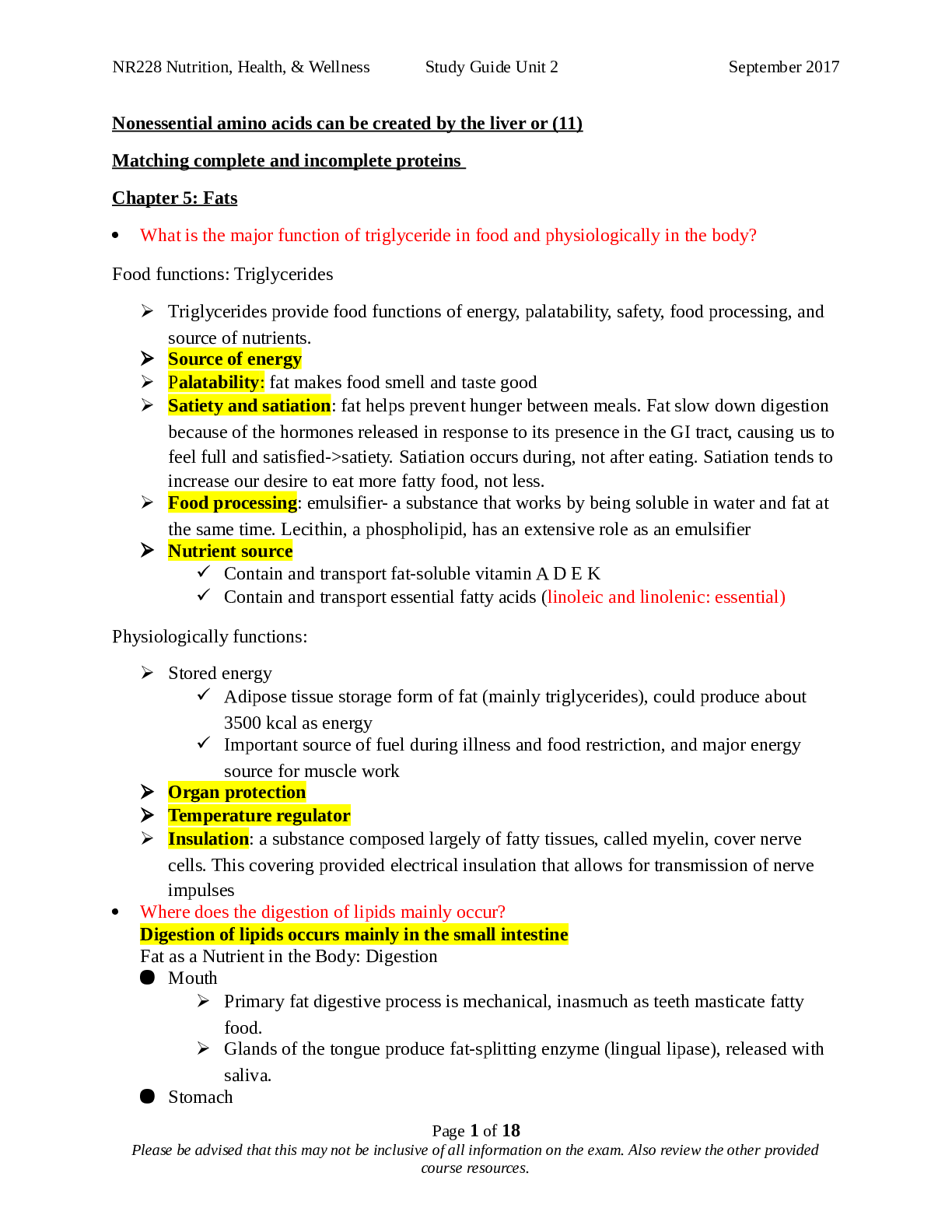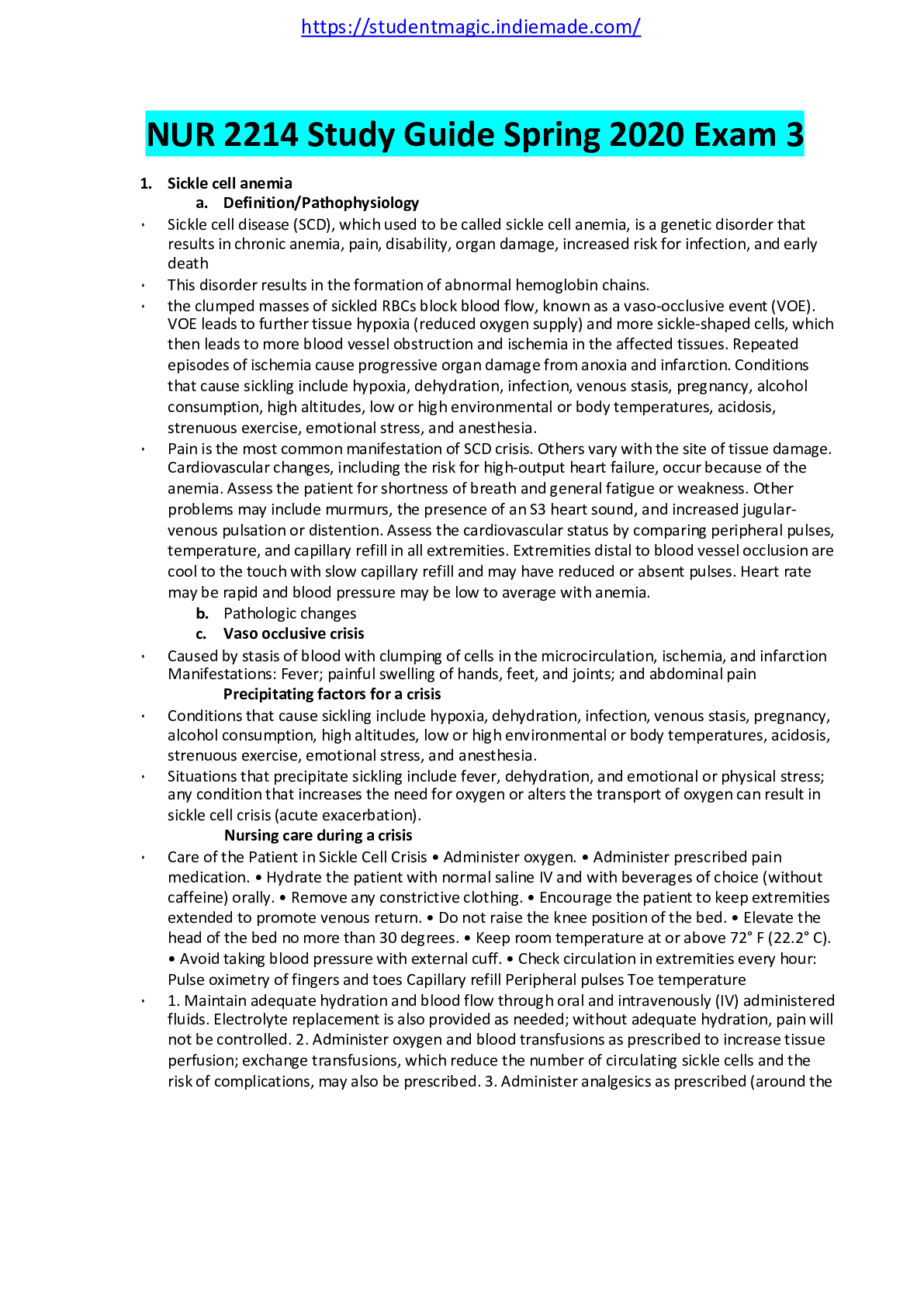Health Care > STUDY GUIDE > Core Mandatory Part II (Nursing) Study Guide (All)
Core Mandatory Part II (Nursing) Study Guide
Document Content and Description Below
Section 1: Age-Specific Patient Care Introduction Every patient is different – and so is every age group. As a caregiver, you must be aware of certain considerations related to each age group and... ways to effectively communicate with patients of various ages. It is important to understand patient needs and what they might be facing at certain times of their lives. This can help you identify issues such as speech or hearing impairments, stress, learning disabilities, depression, and much more. Educating yourself about these factors can help you deliver the best care possible to your patients. Purpose/Overall Goal This module outlines age-specific care and best practices for nine different age groups, from birth to age 80 and beyond. The goal of this module is to provide healthcare workers with information on how to physical, emotional, social, spiritual, and other needs for different age groups, and how to adjust your patient care with age-specific needs in mind. Course Objectives After completing this module, the learner should be able to: • Demonstrate appropriate communication skills for various age groups • Describe appropriate healthcare practices for various age groups • Explain physical and emotional considerations for patients of different ages • Describe common health conditions to assess in patients at various life stages Communication Across the Ages As a healthcare worker, clear communication with patients is key to providing good age- specific care. Each age group has unique physical, psychosocial, and cognitive needs, as well as unique fears and stressors. By understanding the age-specific needs usually associated with each stage of life, you can provide better, more appropriate care, tailored to the needs of each individual. For every patient across all age groups you should: Assess primary language • Check for speech or hearing impairments Core Mandatory Part II (Nursing) © 2021 Relias LLC. All rights reserved. Page | 4 • Check for confusion, depression, and signs of illness or stress • Be aware of possible learning disabilities • Be mindful of cultural differences • Understand family structure Regardless of a patient’s age, caregivers must respond to the need of each patient and family for: • Safety • Privacy • Confidentiality • Comfort • Pain management • Healthcare choices Complex Communication Needs Keep in mind that individuals with complex communication needs (CCN) who cannot communicate by natural speech alone have the same social, emotional, and physical needs as other individuals. Communication supports, also known as augmentative and alternative communication (AAC), can help these individuals express themselves. Examples of AACs include: • Gestures and body language • Sign language • Paper and pencil written communications • Picture boards or books • Devices that produce voice output (speech generating devices) or written output • Electronic communication aids that use picture symbols, letters, and/or words and phrases to create messages Neonates: Birth-28 Days The first 28 days of life are a time when neonates are in a state of total dependency and their basic body functions are being established. The following is a checklist of functions to test: • Reflexes such as grasping, gagging, and startling • Vital signs (temperature, pulse, respiration) • Steady weight gain • Blood glucose levels when appropriate Keep these practices in mind: • Always handle the neonate in a gentle, comforting manner to avoid overstimulation. • Swaddling increases feeling of security and comfort. • Teach parents proper childcare skills for feeding, diapering, cord care, and bathing. • Teach parents to always put the baby down on his or her back for sleeping, to help avoid sudden infant death syndrome (SIDS). • Make sure parents understand the importance of safety devices such as car seats. Core Mandatory Part II (Nursing) © 2021 Relias LLC. All rights reserved. Page | 5 Infants and Toddlers: 0-3 Years Infants and toddlers grow and learn rapidly. Although they are dependent, this is when they begin to develop a separate self. With infants: • Limit the number of staff workers assigned to each one to avoid “stranger anxiety.” • Always speak to an infant before a touch to avoid startling him or her. When delivering care to toddlers: • Keep in mind that toddlers are impulsive and their moods change quickly. • Expect an exaggerated response to pain, frustration, and changes in the environment. • Give one direction at a time, since toddlers have a short attention span. • Speak at eye level with the child and maintain eye contact. • Discuss procedures with toddlers immediately before they happen, not too far in advance, since their sense of time is the immediate present. • Use play to prepare for and explain procedures. • Provide support and comfort during procedures. • Use the least intrusive procedures possible, such as axillary temperature and oral medications. When speaking with parents: • Emphasize proper hand-washing as a way to prevent disease transmission. • Encourage parents to communicate with the child, and to touch and cuddle. In infants and young children, small veins may make inserting an intravenous (IV) line a challenge. Keep these facts in mind: • Be aware that the child may want to play with the IV tubing. • Secure the site with a transparent dressing so you can see it easily. • Inspect and palpate the site every hour. • Avoid wrapping tape too tightly. Young Children: 4-6 Years For children ages 4 to 6 years, some common fears are the dark, being left alone, and bodily injury. It is important to advise parents to: • Keep immunizations and checkups on schedule • Teach the child healthy habits for nutrition and grooming • Learn about safety equipment such as bicycle helmets, elbow pads, and kneepads • Enforce safety issues regarding fire and pools When providing care: • Explain the procedure to the child as well as the parents. • Never lie to the child about whether something will hurt; instead, tell the child that it won’t hurt for long. • Preschoolers are beginning to explore their own bodies, so procedures involving the genitalia can be especially anxiety-producing. • Explain when parents will return; preschoolers can understand this concept and can find it comforting. • Keep in mind that children of this age engage in magical thinking and may become Core Mandatory Part II (Nursing) © 2021 Relias LLC. All rights reserved. Page | 6 fearful based upon imagined threats. • Emphasize that the child will wake up after anesthesia. Be extra careful when giving medications to infants and young children. • Because of their small size and immature body systems, children are at a higher risk for adverse effects. • Medication errors are three times more common among pediatric patients as compared to adult patients. • Medication errors have 10 times the potential for harm in children. Older Children: 7-12 Years For children ages 7 to 12, use these approaches: • Talk, sing, or use distractions such as colorful stickers to divert attention from frightening procedures. • Encourage the child to ask questions and talk about feelings. • Respect the child’s need for privacy. • Allow the child to make some care decisions (such as “In which arm do you want the injection?”). • Give permission to display fear or pain. • Prepare the child for procedures ahead of time. • Ensure that the child understands the healthcare information you provide. Keep these factors in mind for children at this age: • They may have a great fear of the unknown, pain, death, loss of control, or disappointing others. • They may resent forced dependence and lack of privacy. • They may view illness or pain with guilt or as punishment. • Living up to expectations is very important. Adolescents: 13-20 Years Between ages 13 and 20, an adolescent’s body grows into sexually maturity, and complex thinking develops. Keep the following in mind when caring for adolescents: • Adolescent patients should be treated as adults to foster an atmosphere of trust and respect. • Speak directly to adolescents instead of talking through their parents. • Invite adolescents to participate in decision making and whether a parent should be present. • Respect privacy and opinions. • Encourage questions and verbalization of feelings. • Be honest. • Explain treatments and procedures thoroughly. • Be considerate of how procedures, treatments, etc., may affect appearances and relationships. • Discuss plans for future and how illness may affect it. Core Mandatory Part II (Nursing) © 2021 Relias LLC. All rights reserved. Page | 7 When working with adolescents: • Check for signs of common adolescent health problems such as the nutritional disorders, obesity, anorexia, bulimia, and sexually related health problems such as STDs. • Adolescents with a family history of genetically related diseases should learn about their family history and be screened appropriately. • Adolescent girls should be taught breast self-examination; adolescent boys should be taught testicular self-examination. • Maintain an updated knowledge base about acne causes and treatments, since acne is a major concern for this age group. • Assess illicit substance use and sexual activity in private. • Seek follow-up referral or resources if you notice signs of depression or suicidal thoughts; suicide is the third most frequent cause of death in this age group. • Provide support, information, and encouragement related to threats to body image. • Expect that adolescents may experience mood swings due to hormonal changes, relationships with parents and peers, and identity adjustments. • Adolescents may experience increased perception of pain. Young Adults: 21-39 Years Key concerns when caring for young adults age 21 to 39 are support, honesty, and respect for personal values. Stress can be a factor, since this stage of life usually includes major changes such as marriage, having children, and career adjustments. Age-specific care for young adults includes: • Involve patients with their plan of care and in making decisions. • Support their health care decisions, even if you disagree with them. • Explore the impact of their hospitalization or illness on work, family, and other commitments. • Never use terms of endearment (such as honey, sweetie, darling). • Acknowledge and respect their commitments to family and career. • Acknowledge and address their worries about the future. Middle Adults: 40-64 Years Adults ages 40 to 64 are often reevaluating priorities and making plans for retirement. Respect the fact that most middle-aged adults are at the peak of their influence and authority, and they may be distressed by forced dependency in the patient role. Be alert for: • Serious chronic conditions that often develop at this age, such as diabetes, breast cancer, and prostate disorders • Stress from a midlife crisis that may result in depression or other mental issues • Stress from being in the “sandwich generation” – the generation responsible for caring for their parents as well as their children Age-specific care for this age group includes: • If appropriate, encourage talking about concerns, plans, finances. Core Mandatory Part II (Nursing) © 2021 Relias LLC. All rights reserved. Page | 8 • Keep a hopeful attitude and help patients concentrate on strengths, not limitations. • Respect their decisions and give them as much control over their care as possible. • Never use terms of endearment (honey, sweetie, darling). • Allow verbalization of fears and concerns. • Provide privacy. Check for the following conditions: • Skin breakdown due to dryness and decreased subcutaneous tissue • Hypertension and hyperlipidemia, which may not be the cause of hospitalization but may be detected during hospitalization • Sleep apnea • Skeletal injury due to diminished bone density and osteoporosis, especially in women • Obesity due to slower metabolism • Nutritional deficiencies • Farsightedness, which is common in middle-aged patients; if the patient does not have reading glasses or magnifiers, ensure that any important reading material (such as forms requiring signature, menus, etc.) is printed in a larger type size, or read the materials aloud for the patient [Show More]
Last updated: 1 year ago
Preview 1 out of 48 pages

Reviews( 0 )
Document information
Connected school, study & course
About the document
Uploaded On
Jun 26, 2022
Number of pages
48
Written in
Additional information
This document has been written for:
Uploaded
Jun 26, 2022
Downloads
0
Views
47


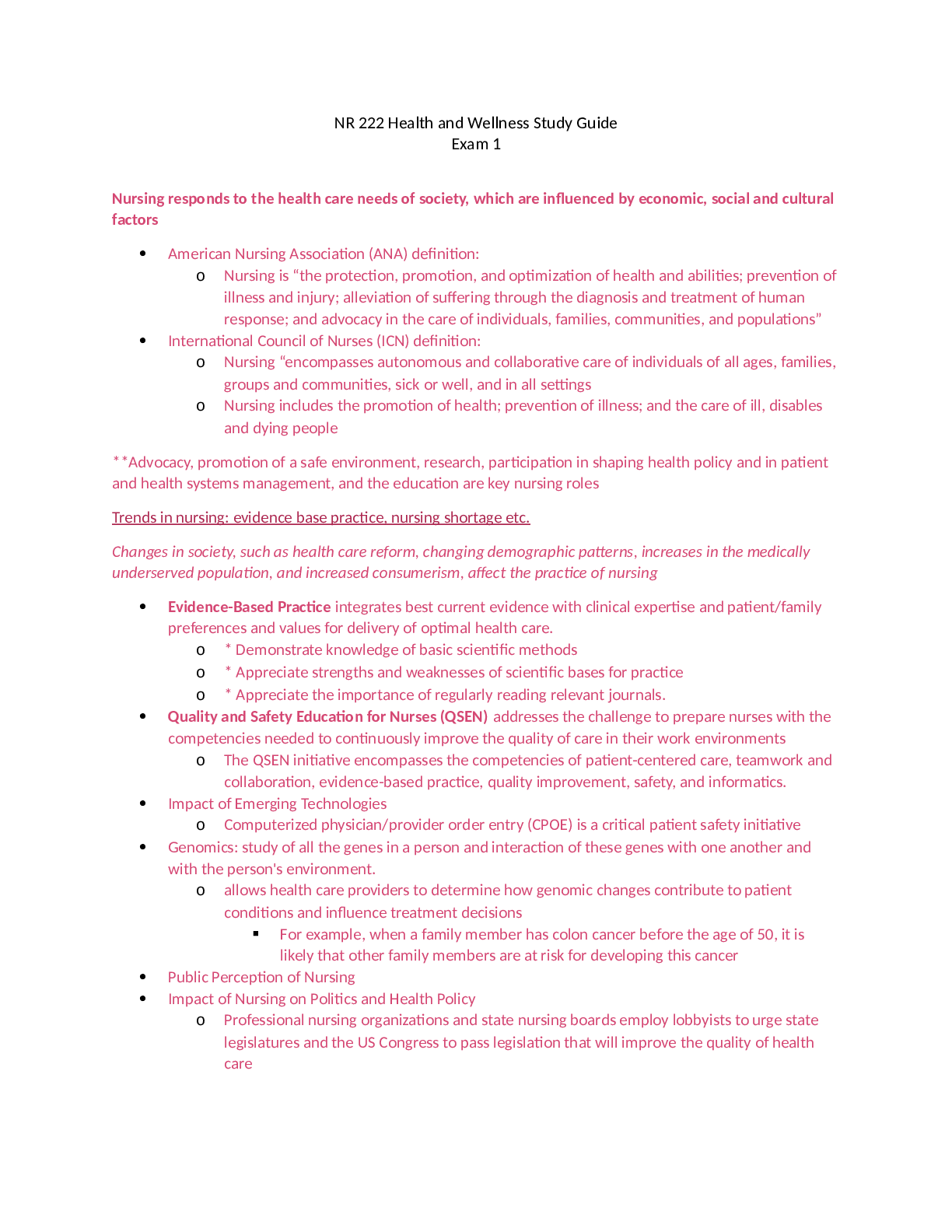
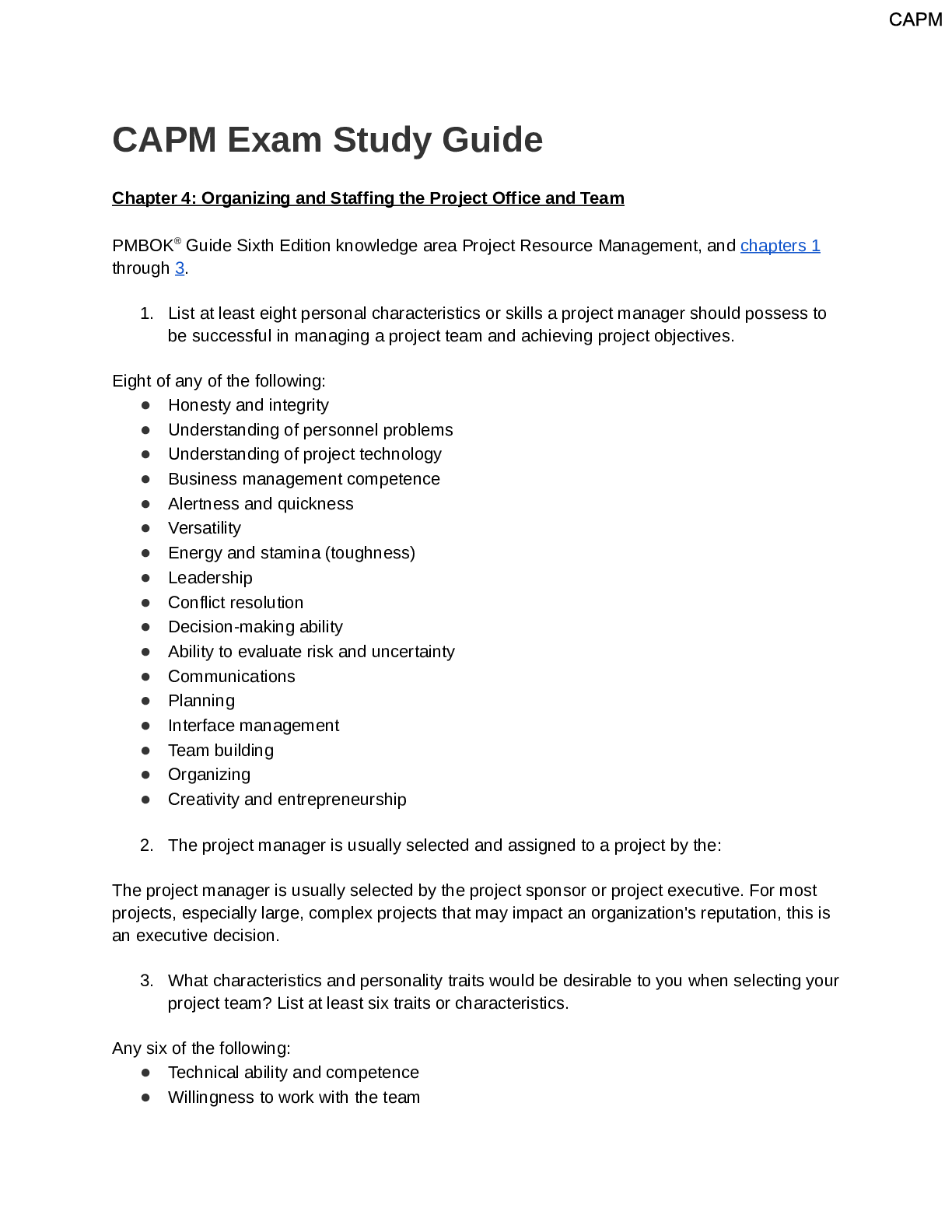
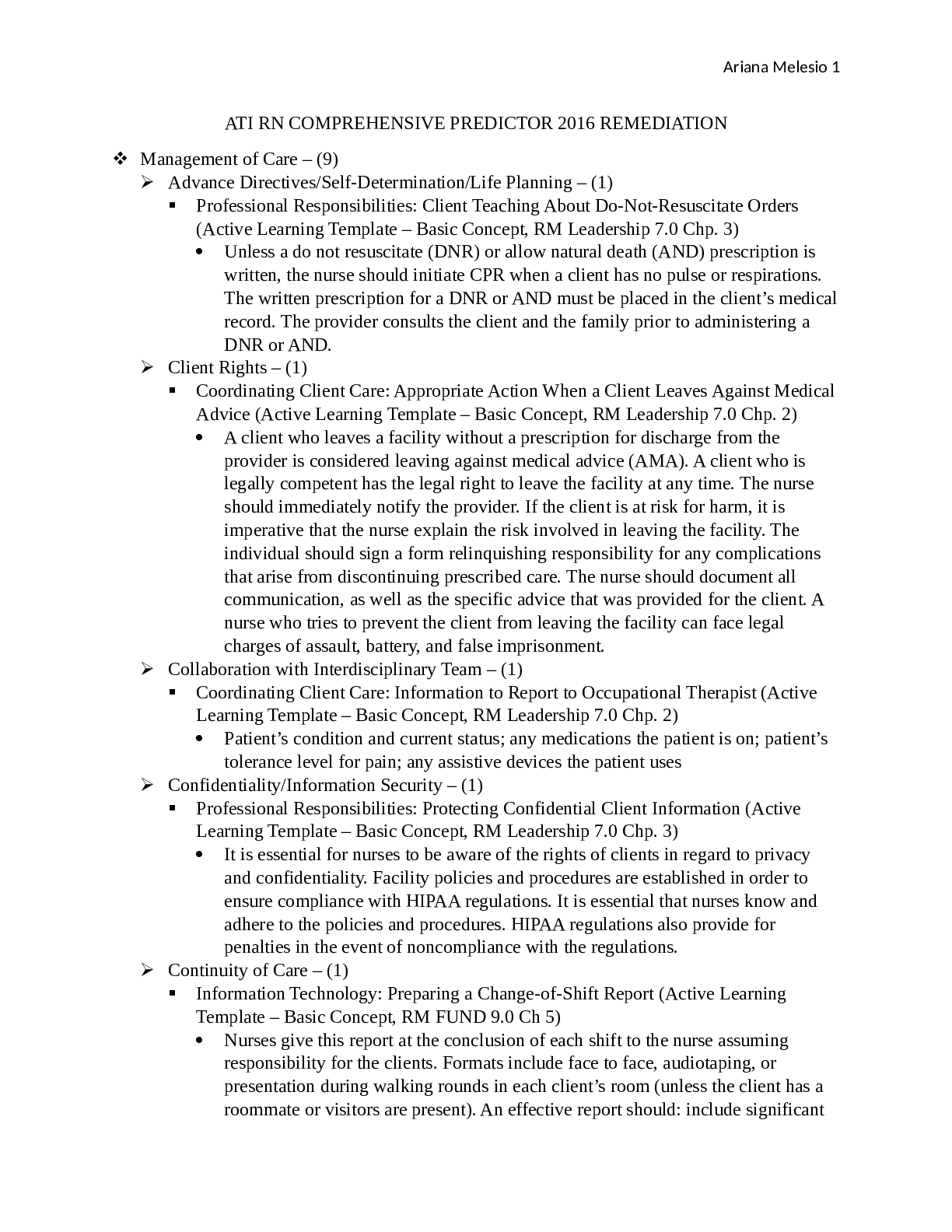
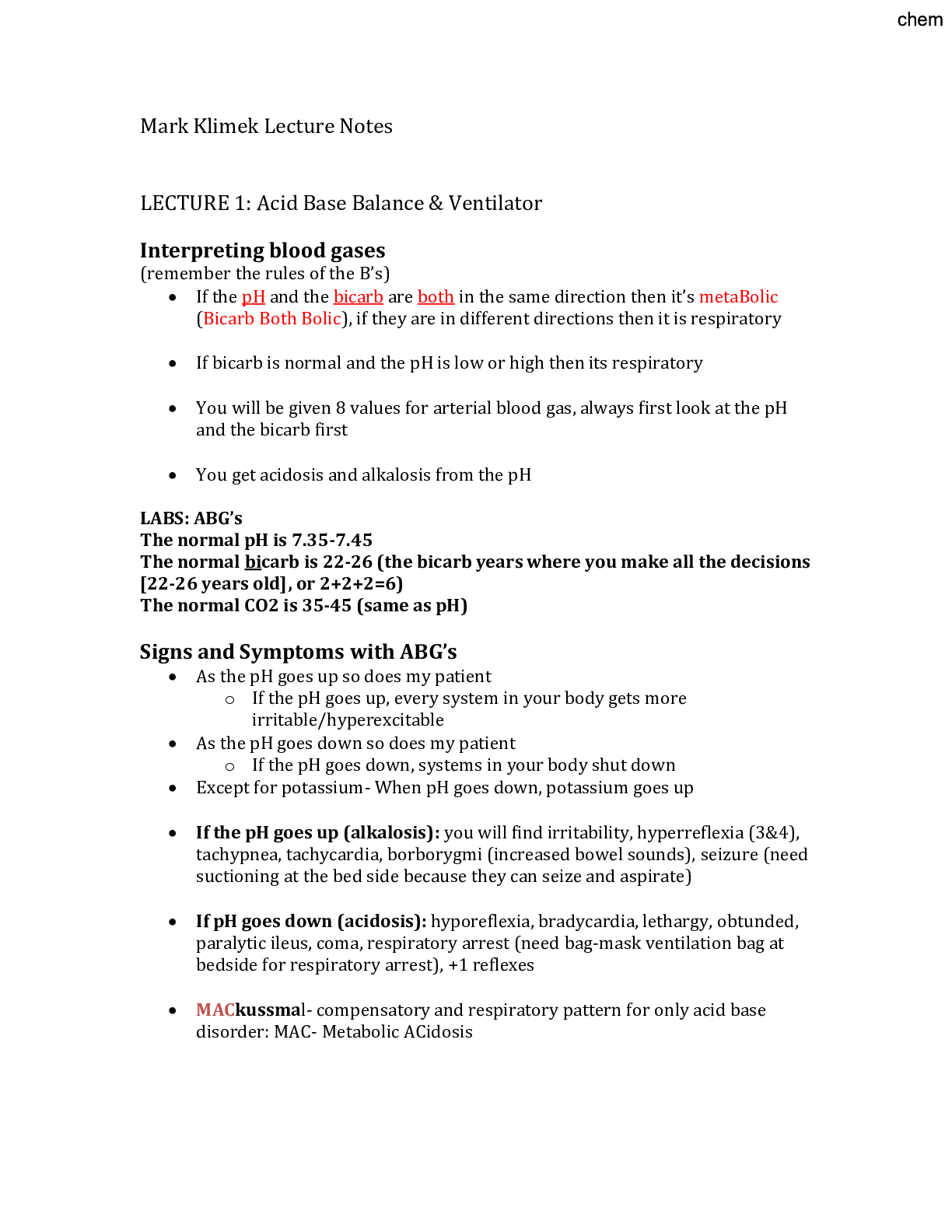






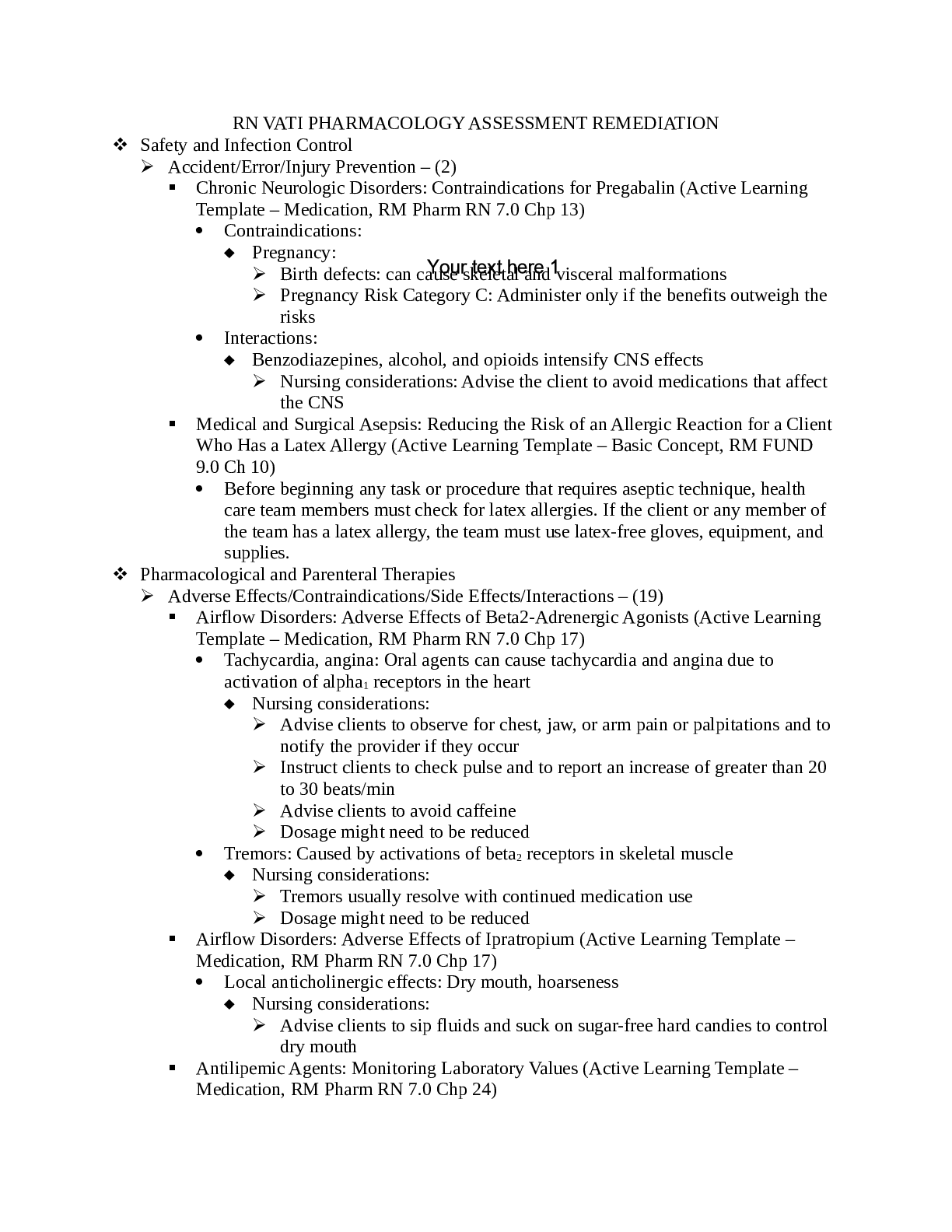
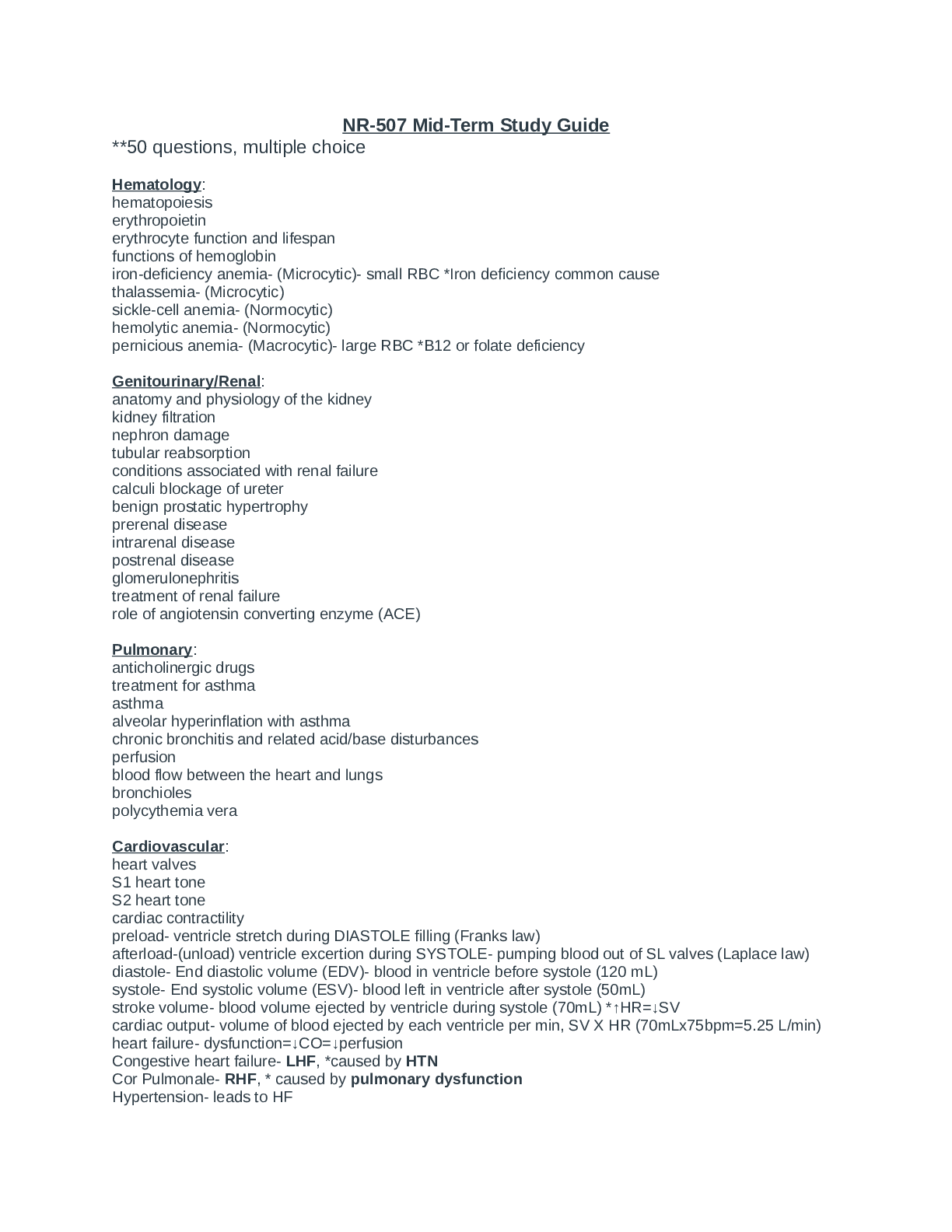










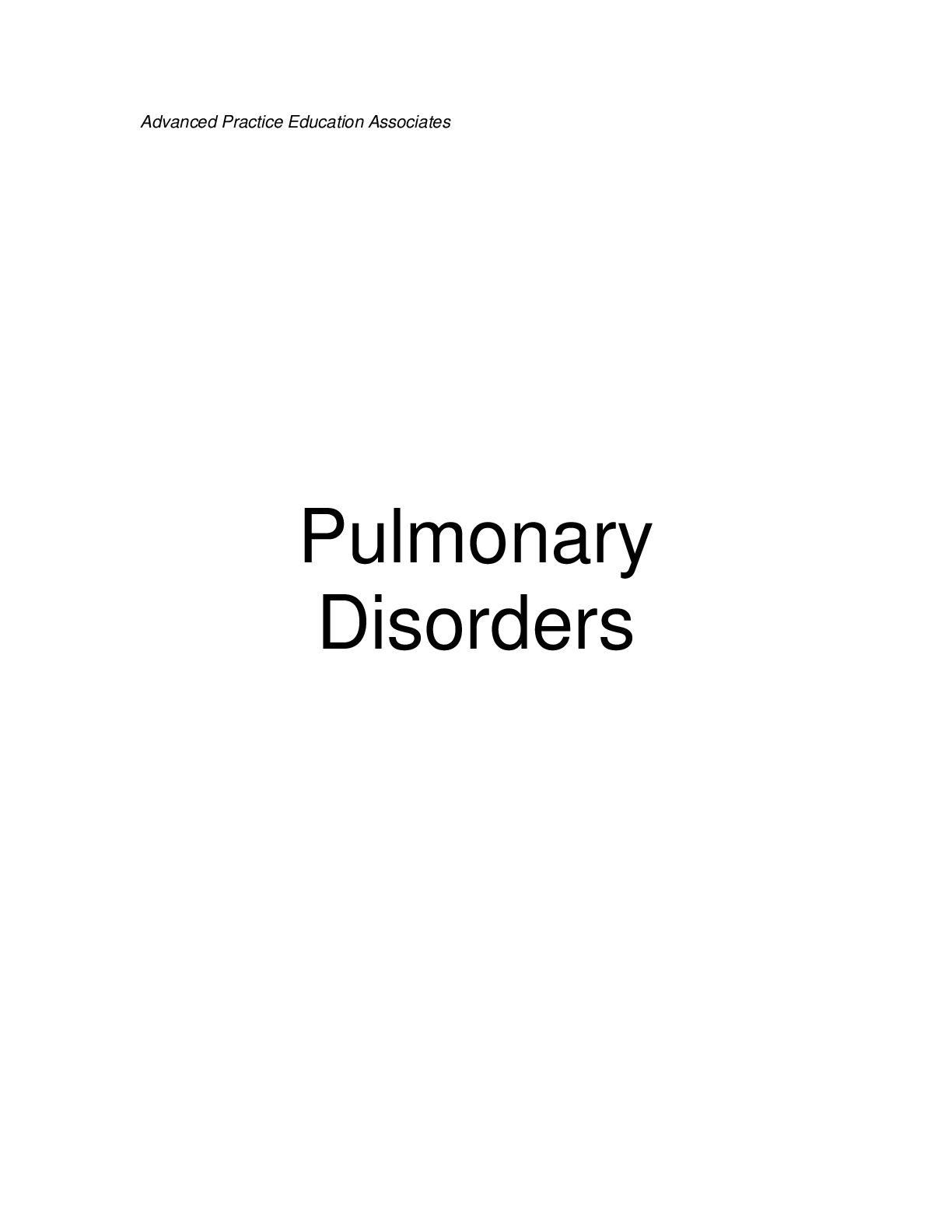
.png)





